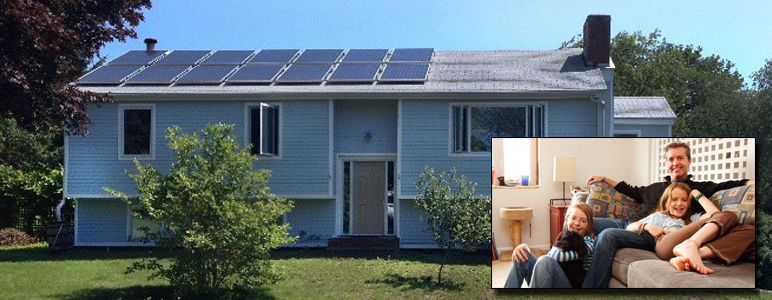


As our nation faces another summer season of hurricanes and wildfires it is clear to most that increasingly severe weather is caused by a warming climate. While many states are members of the U.S. Climate Alliance, and are on track to meet and potentially exceed their portion of our nation’s commitment under the Paris climate agreement, we can’t rely solely on our cities and towns, states or the federal government to solve all the issues related to creating climate change. It’s up to us, the people, to help shape the fate of our planet—and the best time to act is now.
Our homes can be a dynamic and restorative force in society and a powerful tool to address the climate crisis. If every home in the nation were renovated to be energy-producing, we would meet most of our Paris carbon reduction commitment. A positive energy home does just that—it produces more energy than it uses.
I created Massachusetts’ first positive energy renovated home several years ago in Gloucester. Behind the simple exterior is a super-insulated home that has no carbon footprint or net energy bills and is good for the planet. It is also a change agent in our neighborhood, inspiring 12 other neighbors to install solar on their homes.
Watch Livermore's award-winning video about his home energy upgrade at Healthy Home Healthy Planet.
Benefits of energy upgrades
While some carbon reduction strategies, such as dietary changes or reduced air travel, may be seen as restricting personal choice, our positive energy home actually enhances our lifestyle and our community. In addition to zero carbon and zero energy bills, this energy-producing home provides significant benefits that redefine what a house can do.
- Improved comfort: Due to increased insulation, we feel warmer in the winter and cooler in the summer.
- Improved health: With reduced air leaks and a ventilation system, the relative humidity stays in a healthy range where viruses and allergens don’t thrive—so less missed work and trips to the doctor.
- Increased property value: With no net energy bills, solar power on the roof and greater resilience to power outages and storms, our estimated increased property value is over $40,000.
- Benefits our community: We recently donated $1,000 of “banked” solar electricity on our electric bill to two Gloucester families struggling to pay their electric bills.
Renovating our house has also empowered us. When we started to take control of our carbon footprint, as we aligned our actions with our values, our feelings of being overwhelmed flipped into a sense of strength. We discovered we could make a meaningful difference without waiting for the government to lead.
Resources for financing
There are numerous resources, programs and tax credits available across the nation to most residents who want to take control of their home’s carbon footprint and make a positive impact. Tens of thousands of dollars in free services, rebates and incentives for energy efficiency and renewable energy are available through state, utility and local programs.
In most areas, you can obtain low-interest loans to cover costs for home upgrades and there are various incentives for energy-saving and renewable energy technologies. Even using standard loan products, bundling solar photovoltaics (PV) with energy-efficient renovations can result in positive monthly cash flow. The 30 percent federal tax credit significantly helps offset the cost of installing solar.
Below are the costs for the home energy renovation of our 2,400-square foot house. They factor in all rebates and tax credits but do not include my time. The cost of solar continues to decrease so the expense would be less today.
Project cost breakout (approx.)
Lumber and materials: $9,000
Closed-cell foam insulation: $7,000
High-performance windows/doors: $19,000
Solar hot water system: $11,500
Solar PV system: $9,000
Attic insulation: $1,000
Other materials/labor: $4,000
Total: $60,500
When we think of our home as a tool to help preserve a livable climate, we are empowered to be part of the solution. Let’s act now to make a positive difference for our families, our communities, our economy and our planet. Together we can redefine what a house can be—we can redefine what’s possible.
This article originally appeared in CommonWealth magazine, September 30, 2017.

